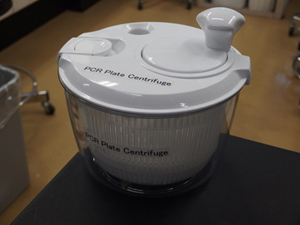Manual centrifuge equipment for 96-well PCR plates
![]() Manual centrifuge equipment for 96-well PCR plates
Manual centrifuge equipment for 96-well PCR plates
| Usually, an electric centrifuge is used to spin down solutions in a 96-well
PCR plate. However, electric centrifuges do not accelerate rapidly and
occupy considerable space on a laboratory bench. An online literature search
yielded a description of a device that utilized a salad spinner to spin
down solutions in a 96-well PCR plate. Inspired by this example, we created
a similar manual centrifuge for two 96-well PCR plates. This equipment
has several advantages over conventional electric centrifuges for 96-well
PCR plates. First, our manual centrifuge accelerates more rapidly than
a conventional electric centrifuge. Second, you do not need to place the
centrifuge in the allocated space on a laboratory bench. When not in use,
our manual centrifuge can be easily stored under the bench. Third, because
of its ultra-light weight, this centrifuge for 96-well PCR plates can be
effortlessly retrieved from storage when necessary. 1. Construction of a manual centrifuge for 96-well PCR plates 1. Acquire a suitable salad spinner. ※You should select a salad spinner of a sufficient size so that it can accommodate two 96-well PCR plates. ※One example is the Petit chef Jr. salad spinner C-750 (PEARL METAL Co., Ltd.) (cost, ~2,000 yen) 2. Cut out a piece of polystyrene foam to fix two 96-well PCR plates inside the salad spinner(See the photograph). 3. Place the polystyrene foam into the bottom of the salad spinner. 2. Advantages 1. Our manual centrifuge for 96-well PCR plates accelerates faster than the electric centrifuge. 2. Our manual centrifuge is operated by simple rotational movements. 3. When not in use, our manual centrifuge can be stored under a laboratory bench. |
|||||||||
|
|||||||||
 |
 |
||||||||
 |
||||
| Return to "Technical tips" | ||||
| E-mail: |